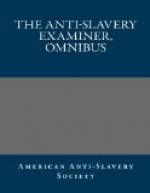ANSWER.—Several societies have been formed in the Methodist connection within the last two years,—although most of the Methodists who are abolitionists, are members of societies auxiliary to the American. These societies have been originated by Ministers, and others of weight and influence, who think that their brethren can be more easily persuaded, as a religious body, to aid in the anti-slavery movement by this twofold action. None of the large religious denominations bid fairer soon to be on the side of emancipation than the Methodist. Of the number of the Methodist societies that are not auxiliary, I am not informed.—The ILLINOIS SOCIETY comes under the same class. The REV. ELIJAH P. LOVEJOY, the corresponding secretary, was slain by a mob, a few days after its organization. It has not held a meeting since; and I have no data for stating the number of its members. It is supposed not to be large.—Neither is the DELAWARE SOCIETY, organized, a few weeks ago, at Wilmington, auxiliary to the American. I have no information as to its numbers.—The MANUMISSION SOCIETY in this city, formed in 1785, with JOHN JAY its first, and ALEXANDER HAMILTON its second president, might, from its name, be supposed to be affiliated with the American. Originally, its object, so far as regarded the slaves, and those illegally held in bondage in this state, was, in a great measure, similar. Slavery being extinguished in New-York in 1827, as a state system, the efforts of the Manumission Society are limited now to the rescue, from kidnappers and others, of such persons as are really free by the laws, but who have been reduced to slavery. Of the old Abolition societies, organized in the time, and under the influence of Franklin and Rush and Jay, and the most active of their coadjutors, but few remain. Their declension may be ascribed to this defect,—they did not inflexibly ask for immediate emancipation.—The PENNSYLVANIA ABOLITION SOCIETY, formed in 1789, with DR. FRANKLIN, president, and DR. RUSH, secretary, is still in existence—but unconnected with the American Society. Some of the most active and benevolent members of both the associations last named, are members of the American Society. Besides the societies already mentioned, there may be in the country a few others of anti-slavery name; but they are of small note and efficiency, and are unconnected with this.
“3. Have you affiliation, intercourse, or connection with any similar societies out of the United States, and in what countries?”
ANSWER.—A few societies have spontaneously sprung up in Canada. Two have declared themselves auxiliary to the American. We have an agent—a native of the United States—in Upper Canada; not with a view to the organization of societies, but to the moral and intellectual elevation of the Ten thousand colored people there; most of whom have escaped from slavery in this Republic, to enjoy freedom under the protection of a Monarchy. In Great




